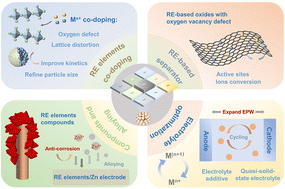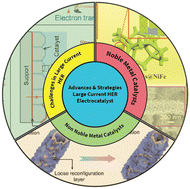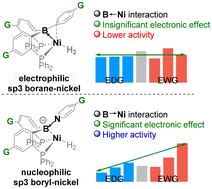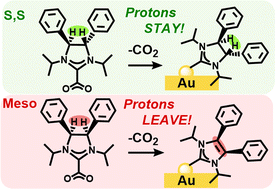Themed collection 2023 Inorganic Chemistry Frontiers HOT articles

Tin as a co-catalyst for electrocatalytic oxidation and reduction reactions
Tin (Sn) as a co-catalyst exerts a substantial influence on multiple electrocatalytic reactions. Delving into Sn's role in electrocatalysts and pioneering novel strategies have an immense impact for green synthesis and energy production.

Inorg. Chem. Front., 2024,11, 1019-1047
https://doi.org/10.1039/D3QI02010J
Hydrogen storage as liquid solar fuels
This review article focuses on catalytic interconversion between hydrogen and liquid or solid solar fuels using metal complexes as redox catalysts.

Inorg. Chem. Front., 2024,11, 981-997
https://doi.org/10.1039/D3QI02239K
Highly efficient tungsten/molybdenum-based electrocatalysts for the oxygen reduction reaction: a review
The mechanisms, synthesis methods and strategies for application of W/Mo-based ORR electrocatalysts are briefly introduced. Recent advances in W/Mo-based ORR electrocatalysts are discussed in detail.

Inorg. Chem. Front., 2024,11, 682-712
https://doi.org/10.1039/D3QI01797D
The role of high-resolution transmission electron microscopy and aberration corrected scanning transmission electron microscopy in unraveling the structure–property relationships of Pt-based fuel cells electrocatalysts
Exploring the nanostructures of platinum-based fuel cell electrocatalysts through the lens of advanced transmission electron microscopy techniques unveils the secrets of structure-activity-stability relationships.

Inorg. Chem. Front., 2024,11, 323-341
https://doi.org/10.1039/D3QI01998E
The chemistry of the s- and p-block elements with 2,2′:6′,2′′-terpyridine ligands
The manifold chemistry of terpyridine (tpy) ligands with main-group elements is reviewed not only to provide an overview on this topic but to also inspire intensified research in this often disregarded field.

Inorg. Chem. Front., 2024,11, 342-399
https://doi.org/10.1039/D3QI01245J
The multiple roles of rare earth elements in the field of photocatalysis
The role and classification of rare earth elements in photocatalysts are summarized, with the aim of providing suggestions for the future development of rare earth photocatalysts.

Inorg. Chem. Front., 2024,11, 11-28
https://doi.org/10.1039/D3QI02006A
Local structural environment of single-atom catalysts
In this review, we discuss the catalytically active sites of single-atom catalysts regulated by modulating the metal single-atoms and coordination environment, as well as summarizing major challenges and development opportunities for the field of SACs.

Inorg. Chem. Front., 2024,11, 29-49
https://doi.org/10.1039/D3QI01576A
Towards scalability: progress in metal oxide charge transport layers for large-area perovskite solar cells
In this review article, we aim to offer a focused overview of metal oxide CTLs for large-area PSCs, emphasizing recent advancements in deposition techniques, modification strategies, and their suitability for large-area device applications.

Inorg. Chem. Front., 2024,11, 50-70
https://doi.org/10.1039/D3QI01757E
Recent advances in electrocatalytic reduction of ambient CO2 toward high-value feedstock
The effects of climate change have arisen due to greenhouse gases emitted into the atmosphere, and the finite supply of fossil fuels will eventually be unable to support the needs of the petrochemical industry.

Inorg. Chem. Front., 2023,10, 7095-7108
https://doi.org/10.1039/D3QI01522J
Recent advances towards increasing the Pt utilization efficiency for hydrogen evolution reaction: a review
Pt, an ideal HER catalyst, is costly, hindering its use in wide-scale applications. Here, we discuss how advances to Pt alloys, heterostructures, and SACs improve Pt atomic utilization for HER, and how spectator ions and pH affect performance.

Inorg. Chem. Front., 2023,10, 6812-6848
https://doi.org/10.1039/D3QI01656K
The importance of second sphere interactions on single molecule magnet performance
Secondary interactions occur beyond the primary coordination sphere and can influence the performance of single molecule magnets (SMMs). This article highlights the role that secondary interactions play in the synthesis and performance of SMMs.

Inorg. Chem. Front., 2023,10, 6427-6439
https://doi.org/10.1039/D3QI01634J
Investigating the role of oxygen vacancies in metal oxide for enhanced electrochemical reduction of NO3− to NH3: mechanistic insights
Ammonia (NH3) is a crucial chemical commodity used extensively in fertilizer production and as a renewable potential energy carrier.

Inorg. Chem. Front., 2023,10, 6440-6488
https://doi.org/10.1039/D3QI01536J
Latest progress in proton-conducting hydrogen-bonded organic frameworks
The latest progress of proton-conductive HOFs in terms of preparation, structural characteristics, proton conductivity, and proton-conducting mechanism are presented. The future trends and design ideas are also highlighted and prospected.

Inorg. Chem. Front., 2023,10, 5856-5884
https://doi.org/10.1039/D3QI01473H
Designing Janus catalysts for renewable energy-relevant bifunctional small molecule activation
Developing bifunctional catalysts is critical for ensuring renewable energy applications via small molecule activation.

Inorg. Chem. Front., 2023,10, 5839-5855
https://doi.org/10.1039/D3QI00954H
Recent advances of metal oxide catalysts for electrochemical NH3 production from nitrogen-containing sources
This article summarizes recent advances in metal oxides catalyzed ammonia production via the electrocatalysis of N2 and nitrates. Critical challenges and future research directions to accomplish their potential industrialization are discussed.

Inorg. Chem. Front., 2023,10, 5812-5838
https://doi.org/10.1039/D3QI01448G
Recent progress and prospects of rare earth elements for advanced aqueous zinc batteries
We analyze the unique roles played by rare earth elements from the three perspectives of cathode, anode and electrolyte. We summarize their potential applications and rational optimization strategies towards electrodes, separators and electrolytes.

Inorg. Chem. Front., 2023,10, 5802-5811
https://doi.org/10.1039/D3QI01117H
Recent advances in molybdenum diselenide-based electrocatalysts: preparation and application in the hydrogen evolution reaction
This review summarizes the preparation of MoSe2-based materials, their application in hydrogen evolution reaction (HER), the catalytic mechanism for improved HER performance, structure–performance correlations and the challenges in the future.

Inorg. Chem. Front., 2023,10, 5517-5554
https://doi.org/10.1039/D3QI00885A
Single-ion magnetism behaviors in lanthanide(III) based coordination frameworks
Incorporating Ln(III) ions into coordination framework structures confers multifunctional properties such as single-ion magnetism, host–guest interactions, and more, which could have broad applications in diverse fields.

Inorg. Chem. Front., 2023,10, 5212-5224
https://doi.org/10.1039/D3QI00925D
Recent developments and prospects for engineering first-row transition metal-based catalysts for electrocatalytic NOx− reduction to ammonia
First-row transition metal-based electrocatalysts, including Cu, Fe, Co, Ni, and Ti-based electrocatalysts, for high-efficiency NOx− reduction are reviewed. These electrocatalysts should possess three advantages indicated in the figure above.

Inorg. Chem. Front., 2023,10, 5225-5243
https://doi.org/10.1039/D3QI01113E
Advances in the application of manganese dioxide and its composites for theranostics
This review summarizes recent advances in the application of manganese dioxide and its composites for theranostics.

Inorg. Chem. Front., 2023,10, 4918-4942
https://doi.org/10.1039/D3QI00978E
Bimetallic-based composites for potassium-ion storage: challenges and perspectives
Bimetallic-based compounds are regarded as promising anode materials. This review highlights design strategies of various bimetallic-based compounds and summarizes the latest research progress, challenges and prospectives for their applications in PIBs.

Inorg. Chem. Front., 2023,10, 4668-4694
https://doi.org/10.1039/D3QI00585B
Recent progress in ammonia synthesis based on photoelectrocatalysis
Photoelectrocatalytic NH3 synthesis from N2 and H2O is a promising approach for N-neutralization goal based on catalytic strategies, such as vacancy engineering, ion doping, frustrated Lewis pair design, heterojunction construction, etc.

Inorg. Chem. Front., 2023,10, 4650-4667
https://doi.org/10.1039/D3QI00683B
Recent advances and strategies of electrocatalysts for large current density industrial hydrogen evolution reaction
The urgent demand for sustainable energy resources has boosted research into highly efficient electrocatalysts for the hydrogen evolution reaction (HER).

Inorg. Chem. Front., 2023,10, 4632-4649
https://doi.org/10.1039/D3QI00799E
Research progress of MXenes and layered double hydroxides for supercapacitors
In this study, the preparation methods of MXenes and layered dihydroxides (LDHs) are reviewed. In addition, the preparation and the electrochemical performances for supercapacitors of MXene/LDHs composites are summarized in detail.

Inorg. Chem. Front., 2023,10, 4358-4392
https://doi.org/10.1039/D3QI00819C
Recent advances in atomically precise metal nanoclusters for electrocatalytic applications
Atomically precise nanoclusters provide a good platform for investigating the actual active sites and reaction mechanisms of electrocatalysis at the atomic or molecular scale, which has been investigated for numerous electrocatalytic applications.

Inorg. Chem. Front., 2023,10, 3995-4007
https://doi.org/10.1039/D3QI00656E
Actinide-based single-molecule magnets: alone or in a group?
This review presents a survey of representative mononuclear and multinuclear actinide SMMs to look back at how far we have come, trying to seek out a feasible strategy for top-performing An-SMMs.

Inorg. Chem. Front., 2023,10, 3742-3755
https://doi.org/10.1039/D3QI00523B
Recent progress and strategies on the design of catalysts for electrochemical ammonia synthesis from nitrate reduction
This review summarizes recent advancements in catalysts for NH3 electrosynthesis from NO3−, highlights various strategies to regulate their apparent or intrinsic activities, and proposes the perspective and challenges in this emerging area.

Inorg. Chem. Front., 2023,10, 3489-3514
https://doi.org/10.1039/D3QI00554B
Understanding the effect of specific adsorption on the vibrational Stark effect of adsorbates on an electrode surface via surface enhanced spectroscopy
Specific adsorption on a surface can substantially enhance the sensitivity of vibrational modes to an interfacial electric field by altering their electronic states.

Inorg. Chem. Front., 2024,11, 756-768
https://doi.org/10.1039/D3QI02122J
A co-axial structure composed of RuO2 on defective N-doped carbon nanotubes as a highly efficient electrocatalyst for overall water splitting
In RuO2-DNCTs, electrons are transferred from defective N to Ru, modifying Ru electronic structure, optimizing the adsorption energy of intermediate species, resulting in an enhanced reaction kinetics for both HER and OER.

Inorg. Chem. Front., 2024,11, 745-755
https://doi.org/10.1039/D3QI02079G
High-pressure observation of elusive iodoplumbic acid in different hydronium-hydrate solid forms
High-energy conditions stabilize iodoplumbic acid in the form of hydronium acid hydrates. The high-pressure reaction of PbI2 and aqueous concentrated hydriodic acid led to two types of hydrated acids and revealed a new polymorph of lead(II) iodide.

Inorg. Chem. Front., 2024,11, 735-744
https://doi.org/10.1039/D3QI01102J
An electron-accepting half-sandwich iridium(III) complex for the treatment of hypoxic tumors via synergetic chemo- and phototherapy
Here is a red light-responsive half-sandwich iridium(III) complex designed for treating hypoxic tumors through a synergistic effect involving apoptosis and ferroptosis.

Inorg. Chem. Front., 2024,11, 436-450
https://doi.org/10.1039/D3QI02047A
Ultrastable and highly efficient hydrogen evolution by heterogeneous NiO/Ni catalysts under industrial electrolysis conditions
The heterojunction of NiO/Ni synergistically optimizes the kinetics during the alkaline hydrogen evolution process, thereby enhancing the catalytic performance beyond that of Pt/C.

Inorg. Chem. Front., 2024,11, 425-435
https://doi.org/10.1039/D3QI01587D
Molecular insight into intrinsic-trap-mediated emission from atomically precise copper-based chalcogenide models
Component-dependent trap sites in copper-related emission were studied using chalcogenide cluster models. In3+ ions in the clusters induce shallow-delocalized traps while Ga3+ ions are associated with carrier localization at deep-localized traps.

Inorg. Chem. Front., 2024,11, 409-416
https://doi.org/10.1039/D3QI02132G
Imine-linked donor–acceptor metal–organic frameworks for an efficient photocatalytic oxidative coupling reaction
We report two imine-linked donor–acceptor (D–A) MOFs with Cu(I) cyclic trinuclear units (CTUs) via Schiff base condensations and their high photocatalytic activity for aerobic oxidation reaction of benzylamines.

Inorg. Chem. Front., 2024,11, 417-424
https://doi.org/10.1039/D3QI02118A
Efficient Nb2O5@g-C3N4 heterostructures for enhanced photocatalytic CO2 reduction with highly selective conversion to CH4
A novel strategy combined with the virtues of both Nb2O5 and g-C3N4 is designed to construct a type II heterojunction, which realizes efficient photocatalytic CO2RR and shows great CH4 selectivity.

Inorg. Chem. Front., 2024,11, 123-132
https://doi.org/10.1039/D3QI01333B
Heterogeneous CoS2/MS2 microspheres for an efficient oxygen evolution reaction
Heterogeneous CoS2/MS2 microspheres lower the overpotential of the oxygen evolution reaction.

Inorg. Chem. Front., 2024,11, 98-106
https://doi.org/10.1039/D3QI01878D
Oxygen defect engineering on low-crystalline iron(III) oxyhydroxide as a highly efficient electrocatalyst for water oxidation
The defects optimized the adsorption capacity of the reaction intermediates during the catalytic process and finally improved the catalytic efficiency.

Inorg. Chem. Front., 2024,11, 114-122
https://doi.org/10.1039/D3QI02043F
Na10Zn(NO3)4(SO3S)4: a nonlinear optical crystal combining inorganic π-conjugated and non-π-conjugated heteroanion groups
Combining non-π-conjugated heteroanionic groups and π-conjugated groups is an effective strategy for obtaining crystals with excellent optical properties.

Inorg. Chem. Front., 2024,11, 107-113
https://doi.org/10.1039/D3QI02107F
Direct coupling of two inert CO2 molecules to form a C–C bond on the Cu0 atomic interfaces of the nitrogen-doped graphene-supported Cu4 cluster
Direct coupling of two inert CO2 molecules to form a CO2 dimer with strong C–C bond over the Cu0 atomic interfaces is proposed based on our periodic density functional theory calculations.

Inorg. Chem. Front., 2024,11, 85-97
https://doi.org/10.1039/D3QI02000B
Fe, S-uniformly dispersed Ni MOFs based on FeS substrate precipitation-dissolution equilibrium for water and seawater oxidation
In the pursuit of advancing electrocatalysts for alkaline oxygen evolution reaction (OER), the development of nickel-based metal–organic frameworks with a judicious balance of cost-effectiveness and catalytic efficacy is of paramount importance.

Inorg. Chem. Front., 2023,10, 7193-7203
https://doi.org/10.1039/D3QI01975F
Depressed P3–O3′ phase transition in an O3-type layered cathode for advanced sodium-ion batteries
The introduction of Cu2+ and Sn4+ ensures the remarkable structure stability of O3-Na0.993Ni0.382Mn0.428Cu0.098Sn0.049O2 to depress the Na+/vacancy rearrangement and P3 → O3′ phase transition, and hence good electrochemical performance.

Inorg. Chem. Front., 2023,10, 7187-7192
https://doi.org/10.1039/D3QI01884A
Copper-based inorganic nanozymes enhance the electrical conductivity of tumors to synergistically induce the pyroptosis, ferroptosis, and apoptosis of tumors
Electrotherapy (ET) effectively ablates solid tumors, inhibiting their growth.

Inorg. Chem. Front., 2023,10, 7176-7186
https://doi.org/10.1039/D3QI01748F
Efficient triplet energy transfer in a 0D metal halide hybrid with long persistence room temperature phosphorescence for time-resolved anti-counterfeiting
Due to strong overlap between the triplet emission of DPTA and 1S0 → 3Px absorption of Sb3+, efficient triplet energy transfer occurs between DPTA and Sb and the afterglow persistence time of DIC:x% Sb can be easily tailored through Sb3+ doping.

Inorg. Chem. Front., 2023,10, 7167-7175
https://doi.org/10.1039/D3QI01774E
Exploring the effect of the reaction conditions on the mechanism of the photocatalytic reduction of CO2 in the vapor phase over Pt/TiO2: an operando FTIR study
CH4 production enhancement upon periodic irradiation cycles.

Inorg. Chem. Front., 2023,10, 7155-7166
https://doi.org/10.1039/D3QI01758C
Distinct electronic effects of borane– and boryl–nickel complexes for catalyzing H2 activation
Electrophilic borane and nucleophilic boryl transition metal catalysts for H2 activation.

Inorg. Chem. Front., 2023,10, 6928-6935
https://doi.org/10.1039/D3QI01561K
Designing a binuclear copper center-incorporated photocatalyst to simulate enzyme catalysis in aerobic hydroxylation of phenylboronic acids
An artificial monooxygenase Cu(I)W–TPT was synthesized from Cu(I), photosensitizer and electronic sponge [P2W18O62]6−, which gave an excellent yield and selectivity in the phenylboronic acid oxidation with the generated ˙O2− through Type I partway.

Inorg. Chem. Front., 2023,10, 6936-6944
https://doi.org/10.1039/D3QI01666H
A supercritical relaxor phase boundary for ultrahigh electrostrictive properties
In this work the design of a critical phase point where reversible transition from the ergodic relaxor state to an unstable long-range ordered ferroelectric state takes place is reported.

Inorg. Chem. Front., 2023,10, 6918-6927
https://doi.org/10.1039/D3QI01636F
Achieving broadband ultraviolet to mid-infrared transparency in germanate-based nonlinear optical crystals Cs3REGe3O9 (RE = Y, Gd)
Two novel Cs3REGe3O9 (RE = Y, Gd) crystals were extracted and exhibit a breakthrough of UV cutoff edge at 210 and 215 nm, respectively, the shortest value among boron-free germanate-based NLO materials.

Inorg. Chem. Front., 2023,10, 6869-6878
https://doi.org/10.1039/D3QI01807E
Luminescence detection of CH2Cl2 by varying Cu⋯Cu interactions in a flexible porous coordination polymer
A flexible Cu(I) coordination polymer is reported as the luminescence sensor for the detection of CH2Cl2. The adsorption of guest molecules lengthens the Cu⋯Cu distance, resulting in luminescent blue shifts and higher emission energy.

Inorg. Chem. Front., 2023,10, 6909-6917
https://doi.org/10.1039/D3QI01723K
Th@C2(8)-C84 and Th@Cs(15)-C84: impact of actinide metal ions on the electronic structures of actinide endohedral metallofullerenes
Two novel endohedral metallofullerenes, Th@C2(8)-C84 and Th@Cs(15)-C84, have been successfully synthesized and fully characterized. Spectroscopic studies suggest that endohedral actinide metal atoms have an important impact on the electronic structures of actinide metallofullerenes.

Inorg. Chem. Front., 2023,10, 6901-6908
https://doi.org/10.1039/D3QI01215H
An eco-friendly electrolyte additive for high-power primary aqueous Mg–air batteries
The introduction of glycine as an additive in NaCl can improve the high-current-density discharge performance of the commercial AZ31 alloy for Mg–air batteries.

Inorg. Chem. Front., 2023,10, 6879-6891
https://doi.org/10.1039/D3QI01223A
Pore environment reinforced laser dye fluorescence in an adenine-containing metal–organic framework with pocket-like channels
Confinement laser dye into two novel adenine-containing metal-organic frameworks with the same components but different pore environments and topologies exhibited distinct adsorptive luminescence behaviours.

Inorg. Chem. Front., 2023,10, 6860-6868
https://doi.org/10.1039/D3QI01569F
Bi-directional strains increase the performance of iridium oxide nanoparticles towards the acidic oxygen evolution reaction in proton exchange membrane electrolyzers
The challenge of achieving high-performance iridium-based catalysts towards the oxygen evolution reaction in proton exchange membrane electrolyzers remains unresolved due to the highly acidic catalyst/PEM interface and oxidation conditions.

Inorg. Chem. Front., 2023,10, 6892-6900
https://doi.org/10.1039/D3QI01609A
Self-promoted ammonia selectivity for the electro-reduction of nitrogen on gt-C3N4 supported single metal catalysts: the machine learning model and physical insights
Intrinsic selectivity and activity correlation by machine learning for the nitrogen reduction reaction.

Inorg. Chem. Front., 2023,10, 6578-6587
https://doi.org/10.1039/D3QI01390A
Dithiocarbazate–Zn(II) complexes for photodynamic therapy and chemotherapy against lung cancer
The Zn(II) complex could efficiently produce ˙O2− to damage lung cancer cells by photodynamic therapy. Simultaneously, the complex can cause cell damage by chemotherapy.

Inorg. Chem. Front., 2023,10, 6526-6536
https://doi.org/10.1039/D3QI01777J
Fabrication of ultrathin two-dimensional MOF nanosheets with cage-like cavities showing excellent adsorption for lead(II)
An ultrathin 2D MOF nanosheet with cage-like cavities was constructed, which showed an outstanding Pb2+ uptake capacity of 738.65 mg g−1 as well as ultrahigh selectivity and anti-interference performance.

Inorg. Chem. Front., 2023,10, 6566-6577
https://doi.org/10.1039/D3QI01619F
LiVTeO5: a mid-infrared nonlinear optical vanadium tellurate crystal exhibiting enhanced second harmonic generation activities and notable birefringence
A novel NLO tellurate crystal, LiVTeO5, was extracted via spontaneous crystallization. It features the attractive merits of a strong SHG response, a large band gap, a wide transmittance range, and a notable birefringence.

Inorg. Chem. Front., 2023,10, 6557-6565
https://doi.org/10.1039/D3QI01715J
Unraveling the effect of carbon morphology evolution in hard carbons on sodium storage performance
Na ions can be effectively inserted into carbon layers with suitable spacing and pseudo-graphitic domains play a crucial role in sodium storage. The plateau capacity is positively correlated with the proportion of pseudo-graphitic domains.

Inorg. Chem. Front., 2023,10, 6547-6556
https://doi.org/10.1039/D3QI01497E
Highly dispersed ultra-small RuO2 nanoparticles on NiO nanosheet arrays as efficient pH-universal hydrogen evolution electrocatalysts
Extremely active RuO2/NiO/NF nanosheet arrays with efficient pH-universal HER electrocatalysis were fabricated via a simple in situ hydrothermal growth strategy.

Inorg. Chem. Front., 2023,10, 6537-6546
https://doi.org/10.1039/D3QI01349A
Reactivity variance between stereoisomers of saturated N-heterocyclic carbenes on gold surfaces
Two stereoisomers, one C2 symmetric and one Cs symmetric, of saturated N-heterocyclic carbenes (NHCs) were placed on gold films and they demonstrate different reactivity.

Inorg. Chem. Front., 2023,10, 6282-6293
https://doi.org/10.1039/D3QI01541F
Guest-induced proton conductivity of two-dimensional layered hydrogen-bonded organic frameworks
We report the self-adaptability of 2D hydrophilic channels of HOFs to guest molecules based on the cyclic SCSC transformation. The studies indicate that the proton conductivity of HOFs depends on the guest-induced hydrogen bonding networks.

Inorg. Chem. Front., 2023,10, 6262-6268
https://doi.org/10.1039/D3QI01401K
Highly stable and differentially arranged hexanuclear lanthanide clusters: structure, assembly mechanism, and magnetic resonance imaging
This study employs diacylhydrazone-derived ligands to realize controllable construction of differentiated hexanuclear lanthanide clusters with identical cores but different template-motif arrangements for the first time.

Inorg. Chem. Front., 2023,10, 6269-6281
https://doi.org/10.1039/D3QI01490H
Efficient iodine capture by metal–organic cubes based on hexanuclear vanadium clusters
Two isostructural metal–organic cubes were self-assembled from large-sized tetradentate ligand constructs with hexanuclear vanadium clusters. They have excellent iodine vapor adsorption properties due to large cavities and host–guest interactions.

Inorg. Chem. Front., 2023,10, 6221-6228
https://doi.org/10.1039/D3QI01501G
MnO synergizes with FeC–FeN in carbon nanofibers to boost oxygen reduction for zinc–air batteries
Carbon nanofibers have been used as a medium to encapsulate FeC, FeN, and MnO together through the electrospinning technology, aiming to synergistically enhance the electrochemical oxygen reduction reaction performance.

Inorg. Chem. Front., 2023,10, 6245-6252
https://doi.org/10.1039/D3QI01483E
A new infrared nonlinear optical material BaZnGeS4 with a wide band gap and large nonlinear optical response
Based on the “electronic structure engineering bucket effect”, a new AEM-containing sulfide BaZnGeS4 with a wide band gap (∼3.36 eV) and large SHG response (∼0.8× AGS) has been designed and synthesized via high-temperature solid-state reactions.

Inorg. Chem. Front., 2023,10, 6253-6261
https://doi.org/10.1039/D3QI01502E
A hundredfold enhancement of relaxation times among Er(III) single-molecule magnets with comparable energy barriers
Three sandwich-type Er(III) SMMs were reported. The relaxation times in the three SMMs are closely correlated with the number of TMS groups on the ligands, that one TMS group resulted in one-order of magnitude change of magnetic relaxation times.

Inorg. Chem. Front., 2023,10, 6236-6244
https://doi.org/10.1039/D3QI01361H
Subtle structural engineering of a coordination polymer host for the fluorescence modulation of host–guest donor–acceptor systems
A novel series of host-guest donor-acceptor (D-A) coordination polymer (CP) materials have been fabricated by subtle structural engineering, which presented multifarious emission properties and illustrated the great potential in achieving fluorescence modulation.

Inorg. Chem. Front., 2023,10, 6229-6235
https://doi.org/10.1039/D3QI01417G
Low-coordination single Ni atoms on graphitic C3N4 for nitrite electroreduction to ammonia
Single Ni atoms on g-C3N4 are verified as an efficient catalyst for electrocatalytic converting NO2− to NH3, which is attributed to the critical role of low-coordination Ni1–N2 moieties in activating and hydrogenating NO2− and retarding the HER.

Inorg. Chem. Front., 2023,10, 5950-5957
https://doi.org/10.1039/D3QI01425H
Ultra-low loading Pt atomic cluster electrode with Pt–O bond as an active site with high hydrogen evolution reaction performance
The oxidized Pt atomic cluster-supported Au electrode (PtAC–O–Au) with ultra-low loading exhibits a very high mass activity, and the active site is the oxidized platinum (Pt–O).

Inorg. Chem. Front., 2023,10, 5937-5949
https://doi.org/10.1039/D3QI01437A
P-doped hard carbon microspheres for sodium-ion battery anodes with superior rate and cyclic performance
P-doping regulates the morphology and microscopic characteristics of hard carbon microspheres to obtain excellent rate and cyclic sodium storage performance. This study provides a method for preparing high-performance P-doped hard carbon.

Inorg. Chem. Front., 2023,10, 5908-5916
https://doi.org/10.1039/D3QI01296D
About this collection
Read our on-going collection of the hottest research published as advanced article from Inorganic Chemistry Frontiers in 2023. These articles are recommended by reviewers as being of significant novelty and interest. Congratulations to all the authors whose articles are featured!